

|
Back to |
| The Front Page |
| News & Features |

|
Game Variations tested by World-Class Players at the NCC |
|
By Bob Alman photos by Yen Sullivan
|
The 2018 Croquet Innovations Tournament introduced the croquet world to Peel Croquet, a game invented by Howard Sosin. That event created a certain momentum. Stephen Mulliner and other participants had said positive things about it, so when a "second annual" was announced--again with top-ranked players--more people took notice. Each day of the late March week at the Center, the audiences on the veranda increased up to the final day, when champions emerged in two games: Peel Croquet and Two-Shot Golf Croquet. Predictably, there was more spectator interest in Two-Shot Croquet than in Peel Croquet (Golf Croquet is so much easier to follow) but devotees of Association Croquet followed Peel Croquet in minute detail, speculating on possible outcomes and strategies, just as if they were watching a major competition. Which, maybe, they were.
When I arrived at the Center on the last day--around 12:30--the Peel Croquet final was already well advanced, between Paddy Chapman and Jamie Burch. (Pete Trimmer had already won the Two-Shot Croquet final.) I don't "know" Association Croquet well enough to comment competently on advanced play; just as in chess, knowing the rules is not enough to master an understanding of what should be done in the next move, all things considered.
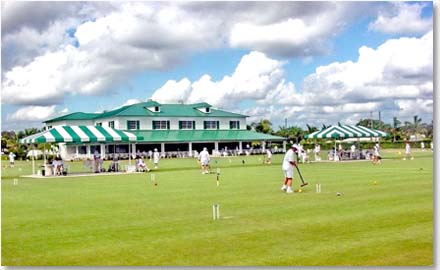
|
| The Croquet Innovations Tournament used the Center's four central courts (of the twelve) to allow the games to be viewed from the clubhouse veranda. |
| Peel Croquet for fun and practice |
|
Peel Croquet can be played and enjoyed by all players who have a modicum of interest and skill in peeling. In particular, while the elite can play a to a 2-Hoop peel/leep requirement, the rest of us can play to a 3-hoop requirement. The extra hoop makes all the difference! By considering/executing all of the peels/leeps that come up in PC, I guarantee that your traditional Triple-Peeling skills will improve. In addition to playing each other as a 3, we can compete with the best they play to a 2 and we play to a 3. We can even have a Pro/Am where we alternate peels. That is, we run a break together, switching with the completion of a peel/leep. Whenever we, the Am play we get 3 hoops for the peel/leep, while the Pro only gets two. (The "leep" is a peel of ball back through the last hoop it scored.)
|
Peel Croquet requires the advanced player to peel (or leep) for each two hoops scored in a single turn--otherwise, the turn ends and the opponent gets a lift to the baulk lines (if there was a peel or a leep in the previous turn), or to contact (if a hoop was made but it was not accompanied by a peel or a leep), or to position (if no hoops, no peels and no leeps were made). (See the complete rules here )
Success requires great concentration, especially as "the plan" of the player may change several times in the course of one turn in a reasonable attempt to maximize net points scored and continue their break.
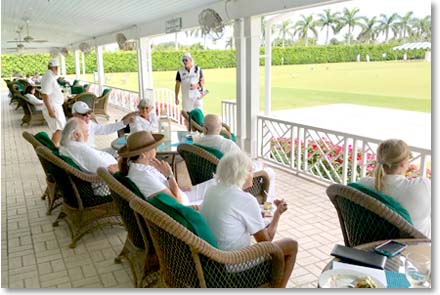
|
Mulliner, who had won a recent Association Croquet world championship here against American pro David Maloof in a marathon five-match final and is also longtime Secretary-General of the World Croquet Federation, wrote this: "After the tournament Pete Trimmer said (and I paraphrase) If we had been playing Peel Croquet all our lives and someone suggested that we instead play AC (our current game), where we are mainly interested in peels at the last three hoops and can continue even if a peel fails, I think we would all opt for PC, with its peel/leep requirement and the possibility of peels and leeps at all hoops.
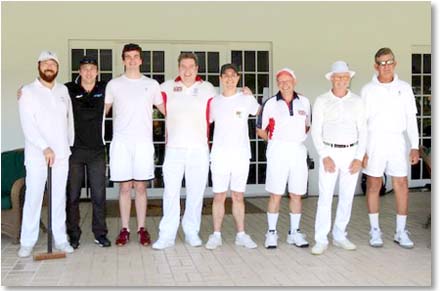
|
| The participants gathered together with the "innovator" on the veranda for their official 2019 portrait: Ben Rothman, Paddy Chapman, Danny Johnston, Pete Trimmer, Jamie Burch, Stephen Mulliner, Howard Sosin, and club pro David Bent. |
An ideal games laboratory: with only the best players
All the players were worthy, the competition was fierce and friendly. Howard Sosin hosted the event like the six-day croquet party it actually was--for both the players and the members of the National Croquet Center who showed up to watch the multi-day testing of Peel Croquet or the week-long evolution of Two-Shot Golf Croquet, as various suggestions were tried and either adopted or rejected.
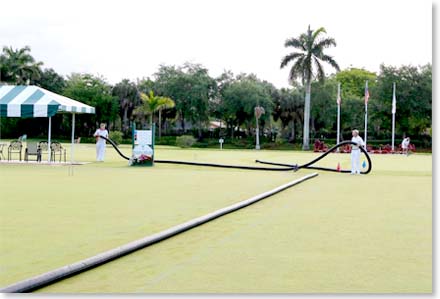
|
| The players were happy to help with adjustments of the court settings, including the light-weight irrigation pipe used for all high-level Golf Croquet events at the Center. |
On the last day, immediately after Chapman claimed his newest prize for Peel Croquet, the finals for Two-Shot Golf Croquet were played on the adjacent Court Seven--like Court Six, directly in front of the veranda--between Pete Trimmer and Jamie Burch. The court was properly lined with black irrigation pipe, to stop the incredibly hard hitting that must be done in any form of Golf Croquet at top level, but less so in Two Shot, where finesse shots dominate. Trimmer won it, 7 to 4.
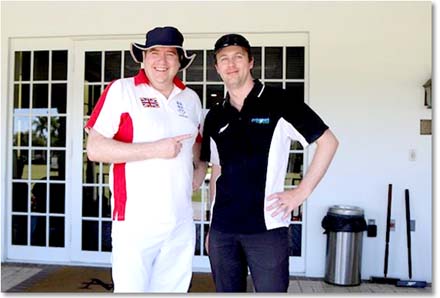
|
| The winners share a moment on the veranda: Pete Trimmer, a bright presence throughout the event and the Two-Shot Golf Croquet winner, points to World Champion Paddy Chapman, who took the top spot in Peel Croquet. |
| An expert's take-away |
|
I tried Peel Croquet in Howard Sosin's Croquet Innovations Tournament in 2018 and can say that I have rarely enjoyed myself as much when playing Association Croquet. The thinking at the start of the break is intense as you have to plot where your peels or "leeps"(backwards peels) are likely to come from. Then you have the issue of execution of the peels and the real possibility that your plans will need to change during the break. This is much more interesting than plodding round on a routine 4-ball break or even a triple. With the adjustments made at the 2019 event, I see Peel Croquet as completing a set of AC versions suitable for all playing conditions. In the most challenging conditions (e.g. Christchurch 2008, 2009 and 2018), use Advanced. In the easiest conditions (e.g. Hurlingham, Roehampton), use Peel Croquet. In the middle of the range, use Super-Advanced.
|
Of course it helps to establish a worthy game in the global culture of croquet, Mulliner added, when you have world and national champions speaking for them, advocating them, and playing them: People like Paddy Chapman, Pete Trimmer, and, for that matter, Mulliner himself.
Club members entertained and enlightened
Howard Sosin's involvement in the event throughout--as host and director of the games and the discussions-- provided focus and seemed to energize the players. In addition to designing croquet games that appeal to top level players, Howard prides himself on creating alternate sets of rules that encourage play by lesser mortals like himself. In Peel Croquet this means having 3 or even 4 hoops within which to meet the peel/leep requirement, instead of just two.
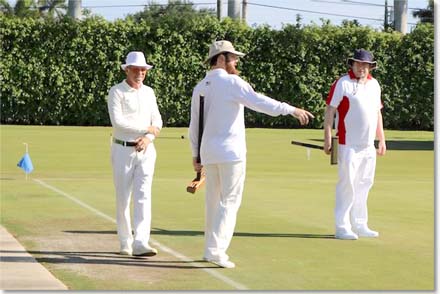
|
| Howard Sosin listens as Ben Rothman appears to explain something that just happened in his Peel Croquet game with Pete Trimmer. |
While the rules of Peel Croquet did not change, Howard clearly enjoyed the many conferences with the players as they continued to experiment with different rules in the Two Shot Golf Croquet game--sometimes chatting on the veranda or in a courtside gazebo, sometimes meeting in the center of the court during a game to examine and explore different options in particular situations.
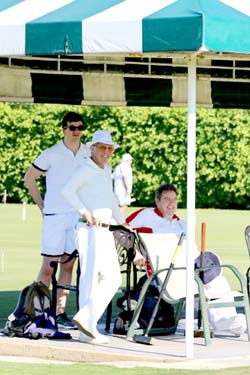
|
| The gazebos are handy for rest, shade, and up-close analysis, here with Danny Johnston, Howard Sosin, and Pete Trimmer. |
You can get another shot--one shot only--by hitting any other ball, and then playing the extra shot from wherever the striker ball stops rolling. There is never more than two shots in a turn. Often in this game a player needs to use another ball as "transportation" to another place on the court for the striker ball. The striker is required to hit one side or the other of the object ball with precisely the right angle and strength to move it to the right place for the second shot--or for his partner to use in the rotation.
That single rule changes the game completely, and a yard-line boundary rule as in Association Croquet enables boundary balls to be in play.
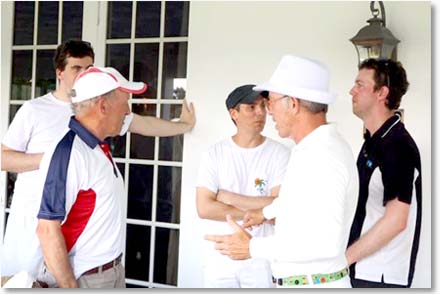
|
| Veranda discussions often became intense: here are Johnston, Mulliner, Burch, Sosin, and Chapman. |
Putting it all in the long-view perspective
Various committees of the English Croquet Association and other national bodies have met together to formulate or propose significant changes in the rules of both "Association Croquet" and Golf Croquet, and there is glacially slow movement towards creating uniformity of language and rules around single-ball faults and penalties.
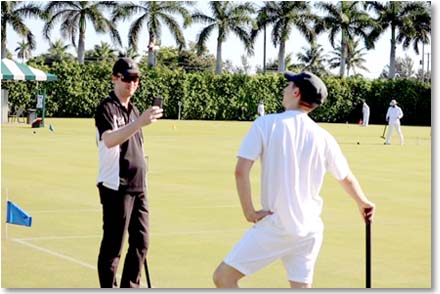
|
| World Champion Paddy Chapman takes a picture of his friend Jamie Burch. Chapman was always easy to spot in a sea of all-white because he was given special permission to wear New Zealand winter blacks on the courts throughout the event. |
The major complaint with Association Croquet, in all its forms, Advanced and Super-Advanced is the lack of player interaction. After the opening, two-turn victories with scores of 26-0 are common-place with the world top players. This results in a lot of sitting for the players which can be tedious for spectators.
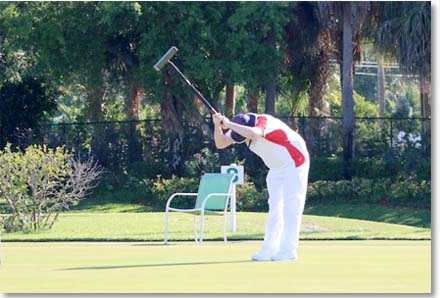
|
| The photographer caught Pete Trimmer at the end of the his follow-through. |
Peel Croquet is much more interactive. Peeling/leeping every two hoops is doable but challenging. Two turn wins are possible, but none occurred during the 6-day Croquet Innovations Tournament. You cannot fail on the peel and then come back and complete it after the next hoop! Guessing which peel/leep the player will choose is great fun for the spectators.
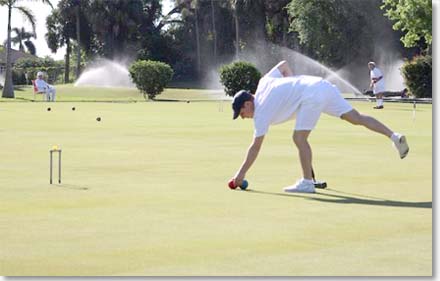
|
| Sprinklers on the newly-redeveloped Palm Courts do not disturb the play of Jamie Burch. But, the Englishman was the losing finalist in both games contested. |
Recording and sharing the games in moving pictures
Russ Dilley videoed the 2018 tournament and kindly came again in 2019 to video this event Russ told me, "This year, I understand it well enough to do commentary on the film." You can find Dilley's edited and narrated version of the 2019 finals on youtube, along with other depictions of the game. Near the beginning of each video is a simple and brief description of the rules.

|
| Russ Dilley videos and narrates major events. In the foreground one of his camera set-ups is beside the table Stephen Mulliner--always in constant motion--is using to report the event to the croquet world and to maintain his job as Secretary-General of the World Croquet Federation. Sosin has credited Mulliner as a "co-creator" of Peel Croquet. |
Sosin acknowledges that Golf Croquet is a wonderfully subtle game that is important to the future of the sport. He sees Two-Shot Golf Croquet as a complement that will allow players to hone additional single-ball shot skills while allowing them to be engaged continuously (as in a "social" game). The 2nd shot adds subtle complexities, but ones that resolve themselves quickly.

|
| A mythical Alice expressing the essential cruelty of the game of croquet is only one of Howard Sosin's contributions to the Center. Flamingos and hedgehogs are never seen at the Center, although alligators and iguanas sometimes appear. Danny Johnston and Ben Rothman look on from the bank of the irrigation pond. |
Will these games achieve their place in a limited playbook of "official" forms of croquet? One never knows. Even the officially adopted games once slated for world championships--like 14-point Advanced Association Croquet--sometimes fail to attract player interest. While on the other hand, John Riches' game called Ricochet, when it became popular at club level, achieved a sufficient a level of currency that justified, finally, tournaments and state and national championships, in its native Australia.
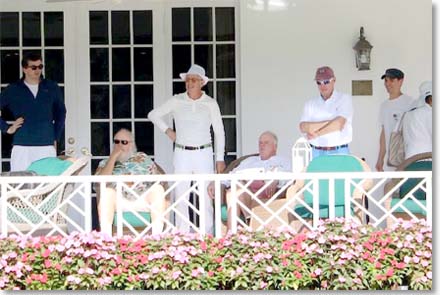
|
| Seated club members mixed with the international players each day of the event. The flowers gracing the veranda are reflected throughout many parts of the 10-acre Center. |
Whether or not Howard Sosin's simple, interesting, and workable variations achieve a broader currency in the global culture of croquet, he has plenty of other concepts around which to draft rules, test on the courts, adjust, and perfect over many days with top-ranked players before submitting them to a world-wide jury of peers in the croquet world.
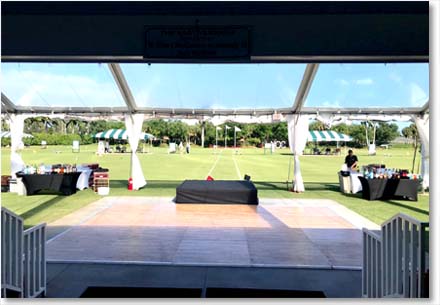
|
| At the end of the Palm Beach "high season" major events for incoming corporate parties mix easily with club activities and special events. In this season, the evening air is perfect for dancing on the broad apron that separates the clubhouse from the courts, and a transparent tent ensures shelter from any passing shower. |
He won't say whether there will be a "third annual" Croquet Innovations Tournament at the National Croquet Center next spring. I'm betting there will be. And in addition to "Collect the Clips", a game that will be played competitively for the first time on May 11 at the NCC, he will likely have come up with other interesting forms of croquet for us to enjoy.
Yen Sullivan enjoys taking photos and spent several days photographing the Croquet Innovations event for Croquet World. She was born as Yanchun (Yen) and educated in Beijing, China, where she received a bachelors degree in finance. She left China for the US in 1988 and enrolled in the Patterson School of Diplomacy and International Commerce at the University of Kentucky, where she earned her Masters degree. After her job brought her to Louisville, she met her future husband Dick, who introduced her to Croquet. Yen is a member of the National Croquet Club and plays at the Westhampton Mallet Club in the summer.